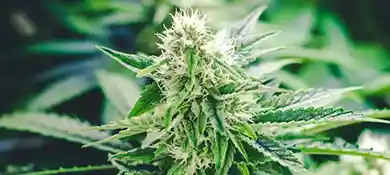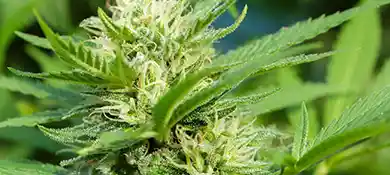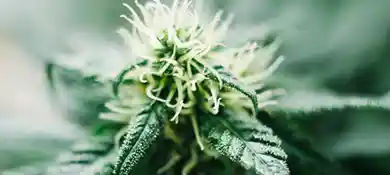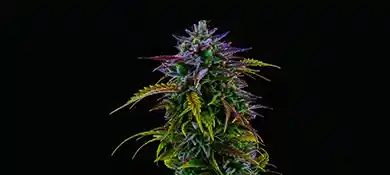Combat Powdery Mildew on Cannabis Effectively(Updated)
Powdery mildew on cannabis is a persistent and common problem for many growers. This fungal disease spreads quickly, damaging plant health and reducing yields. Even if growers effectively cure cannabis powdery mildew, it will still have an impact on the final quality of the plants. As a result, prevention should be the top priority when dealing with powdery mildew on cannabis.
Understanding Powdery Mildew on Cannabis
Since we want to effectively control powdery mildew, it is important to first have a basic understanding of its nature, how it spreads, and the different types of fungi involved.

What is Powdery Mildew on Cannabis
Powdery mildew is a common fungal disease that affects a wide range of plants such as tomatoes, peppers, pumpkins, strawberries, etc. Cannabis plants are no exception.
It is characterized by the growth of powdery white spores on plant surfaces, primarily the leaves, stems, and flowers.
Life Cycle of Powdery Mildew
The life cycle of powdery mildew on cannabis involves both asexual and sexual reproduction, each playing a critical role in the fungus's spread and survival. The asexual phase is the primary driver of rapid infection, while the sexual phase helps ensure the fungus's persistence, even under unfavorable conditions.

1. Asexual Reproduction (3-7 Days)The asexual phase begins when conidia, or asexual spores, land on cannabis plants. These spores can spread rapidly in indoor environments with high humidity and moderate temperatures, typically within 3 to 7 days. Once the spores land on the plant’s surface, they begin to germinate and form new fungal growth, which can quickly cover the leaves, stems, and buds.
As the fungus grows, it produces more spores, which can then spread throughout the grow room. In a closed indoor environment, this cycle can repeat quickly, leading to a fast escalation of the infection.
2. Sexual Reproduction (End of Growth Cycle)Later in the cannabis plant’s life cycle, particularly after flowering, powdery mildew enters its sexual reproduction phase. This phase produces ascocarps, which contain ascospores. These structures are highly resilient, able to survive in harsh conditions, such as when plants are removed or environmental control is not optimal.
In indoor grow rooms, the ascospores can linger in the environment, potentially re-infecting plants in future growing cycles if not properly managed.
3. Transmission and Spread in Indoor Grow RoomsIn an indoor cannabis grow room, powdery mildew spreads primarily through air circulation. The conidia produced during the asexual phase are easily carried by fans, air systems, or any movement in the grow space.
The spores can land on new plants, surfaces, or equipment, creating fresh points of infection. Without effective air circulation management and sanitation practices, the spores can quickly spread throughout the room, causing widespread contamination.
By understanding the lifecycle of powdery mildew in an indoor grow room, growers can take steps to prevent and control the disease before it spreads too far.
Types of Powdery Mildew Fungi
Powdery mildew on cannabis is caused by several different species of fungi, with the most common being Erysiphe and Podosphaera species. Each of these fungi shares similar characteristics but may exhibit slight differences in terms of host preference and environmental adaptability.
Erysiphe cichoracearum thrives in warm, humid environments and is capable of rapidly spreading in indoor grow rooms with poor air circulation. The fungus infects the plant's leaves, stems, and flowers, producing the signature white, powdery coating.
Podosphaera macularis is known for its ability to produce large quantities of conidia, which are easily dispersed throughout the grow room. It can cause significant damage to cannabis plants, particularly during the flowering stage.

The Main Impact of Powdery Mildew on Cannabis
One of the most significant threats to cannabis cultivation is powdery mildew, a fungal pathogen that can severely affect quality and yield of cannabis plants.
Reduced Quality of Cannabis Buds
Reducing quality of cannabis buds is a direct consequence of powdery mildew. The presence of this mold diminishes the aesthetic appeal of the buds and alters their potency and flavor profile, which can be devastating for both recreational and medicinal users. Infected plants may develop a poor aroma, resulting in subpar products that fail to meet consumer expectations.
Furthermore, powdery mildew’s impact on the overall health of the plant can lead to secondary issues, such as reduced resistance to other pests and diseases.
Decreased Cannabis Yield
Decreased Cannabis Yield is another critical impact of powdery mildew. The energy that plants would typically use for growth and bud development is diverted towards fighting off this pathogen. This results in stunted growth and smaller yields.
In addition, the presence of powdery mildew on cannabis plants often necessitates the removal of infected plants, further reducing overall production.
How to Identify Powdery Mildew on Cannabis
This fungal disease typically appears as a white, powdery substance that can affect different parts of the plant.
Powdery Mildew on Leaves
The most common place for powdery mildew to appear on cannabis is the leaves. Early signs of infection typically begin with a fine, white coating on the upper surface of the leaves, often near the veins. As the disease progresses, the spots may grow larger and more prominent, covering much of the leaf surface.
In severe cases, the infected leaves can become yellow and eventually die. Growers should closely monitor the underside of leaves as well, where the spores may be less visible but still present.

Powdery Mildew on Stems
While powdery mildew is more commonly seen on leaves, it can also affect the stems of cannabis plants. The fungus usually starts as small, white patches along the stem, often near nodes or junctions between branches.
As the infection spreads, the patches may grow larger, making the stems look dusty or coated. Infected stems may become weakened, affecting the plant’s overall strength and reducing its ability to transport water and nutrients effectively.

Powdery Mildew on Buds
Powdery mildew on cannabis buds is particularly concerning because it can severely impact the quality of the harvest. Infected buds may show a white, powdery film on the calyxes, which are the small leaf-like structures that protect the developing flowers.
As the mildew spreads, it can penetrate deeper into the buds, damaging the plant’s reproductive structures. Infected buds can become malformed, and the powdery mildew may even affect the trichomes, which are essential for the plant's potency and aroma.
By understanding how to identify powdery mildew on cannabis leaves, stems, and buds, growers can take immediate action to prevent the spread of the disease.
.webp)
Major Triggers of Powdery Mildew on Cannabis
Now that we've covered how to identify powdery mildew on cannabis, it's essential to understand the major environmental factors that trigger its growth, starting with humidity.
Humidity
In general, the fungus needs moisture in the air to trigger the germination of its spores, making fluctuations in humidity levels a primary concern for growers.
Powdery Mildew Thrives in Humidity Fluctuations
Powdery mildew on weed is different from many other fungi in that it does not need water droplets or a damp surface to reproduce. Instead, just a brief period of high humidity is enough for germination to begin and infection to form on the plant surface.
Ideal Humidity Range for Cannabis Cultivation
Each growth stage of cannabis requires a slightly different humidity level to thrive while minimizing the risk of powdery mildew. During the seedling stage, a humidity level of around 65% to 70% is ideal. This higher humidity helps the young plants establish strong root systems and promotes healthy growth. As the plant transitions into the vegetative stage, the humidity should be maintained around 40% to 70%.
During the flowering phase, it's critical to lower the humidity further, ideally to about 40% to 50%. Lower humidity helps reduce the risk of powdery mildew, which can be more damaging during flowering when the plants are more susceptible. Finally, in the post-flowering stage, humidity should be kept at 35% to 50% to ensure the plant remains healthy while it matures and the buds develop.
By carefully controlling humidity during all phases of growth, cannabis growers can create an environment that discourages the development of powdery mildew and supports optimal plant growth.

Temperature
Temperature is another critical factor that influences the development of powdery mildew on cannabis. Temperature fluctuations also play a role, as sudden changes can lead to an unstable environment that encourages powdery mildew.
Temperature Fluctuations and Their Impact on Humidity
The relationship between temperature and relative humidity (RH) is explained by a basic formula: Relative Humidity = (Actual Water Vapor in the Air / Maximum Water Vapor the Air Can Hold at a Given Temperature) × 100.
In simpler terms, when the temperature rises, the air can hold more moisture, which means the relative humidity decreases if the moisture level remains constant. Conversely, if the temperature drops, the air can hold less moisture, causing the relative humidity to increase, even if the moisture level remains the same.

The Optimal Temperature Range for Cannabis
Cannabis plants require different temperature ranges throughout their growth stages to maximize their potential and reduce the risk of disease. During the seedling stage, the ideal temperature range is between 68°F to 77°F (20°C to 25°C). This range ensures that young plants are not exposed to stress while encouraging healthy development.
As cannabis enters the vegetative stage, temperatures can be slightly higher, ranging from 71°F to 82°F (22°C to 28°C). This temperature range promotes vigorous growth, with plants requiring more warmth to fuel their photosynthesis process.
During the flowering stage, the temperature should be slightly reduced to 68°F to 79°F (20°C to 26°C). Lower temperatures during flowering also support resin production and bud formation.
Finally, during the post-flowering stage, temperatures should be maintained between 64°F to 75°F (18°C to 24°C). This helps the plant finish maturing while maintaining a favorable environment for the development of dense, high-quality buds.

Airflow
Proper airflow is one of the most critical factors in preventing powdery mildew on cannabis. Poor airflow can contribute to powdery mildew on cannabis by allowing moisture to accumulate around the plants. Stagnant air creates microclimates with high humidity near the plant surfaces, particularly in dense areas like buds, where moisture is trapped.
By controlling humidity, temperature, and airflow, cannabis growers can significantly reduce the risk of powdery mildew and create an optimal environment for healthy plant growth.
Effective Measures to Prevent Powdery Mildew on Cannabis
Preventing powdery mildew on cannabis requires a careful approach to environmental control. By managing key factors such as temperature, humidity, and airflow, growers can significantly reduce the risk of infection.

Maintain Consistent Temperature to Avoid Fluctuations
Temperature consistency is beneficial for preventing powdery mildew on cannabis, as sudden temperature fluctuations can create an unstable environment conducive to fungal growth. To maintain a stable temperature, growers typically rely on chillers, heaters, and air conditioners. These devices help regulate the temperature for cannabis growth.
However, to achieve more precise control, advanced climate management systems like the Altaqua Grow Room HVAC System provide an even more effective solution.
This system uses narrow temperature differentials to maintain a consistent climate, preventing the fluctuations that encourage mold growth. Featuring high-quality sensors, such as Austria's E + E humidity and temperature sensors, the system offers exceptional accuracy, ensuring ±2.5% RH and ±0.54°F accuracy during operation.
Using Dehumidification System for Stable Humidity Levels
To effectively control humidity and prevent powdery mildew on cannabis, growers often rely on traditional dehumidification systems. These systems work by extracting excess moisture from the air, thereby reducing relative humidity (RH) levels. Standard dehumidifiers are effective but can be influenced by temperature changes within the grow room. For instance, fluctuations caused by grow lights or ventilation systems can alter RH levels, which may not always reflect the true moisture conditions necessary for optimal plant health.
To overcome these limitations, advanced systems like the Altaqua Grow Room HVAC System offer a more precise solution. Unlike traditional dehumidifiers that rely solely on relative humidity, the Altaqua system utilizes dew point temperature, which is temperature-independent and provides a more accurate representation of moisture levels in the air. By measuring and controlling the dew point, this system ensures stable humidity levels.
Optimizing Airflow to Reduce Microclimates
Proper airflow can prevent powdery mildew on cannabis. To achieve consistent airflow, growers commonly use oscillating fans, exhaust fans, and intake fans to ensure air circulates throughout the grow room.
However, beyond traditional ventilation, more advanced climate control solutions like the Altaqua Grow Room HVAC System provide even more efficient airflow management. This system incorporates the use of EC fans, which are designed to adjust the airflow based on real-time environmental data. These fans allow for precise control of air distribution, ensuring that every area of the grow room receives consistent airflow, minimizing the risk of microclimates forming.
By integrating such advanced systems, growers can maintain optimal conditions for plant health while minimizing the risk of powdery mildew.
Comparing Disease Rates of Powdery Mildew With and Without Environmental Control
In plants cultivation, the presence of powdery mildew is closely tied to the cultivation environmental conditions. The level of temperature, humidity, and airflow all contribute significantly to the likelihood of an outbreak. According to the study titled Aspects of the epidemiology and control of powdery mildew (Oidium neolycopersici) on tomato in Ontario, Canada, experiments were conducted in greenhouses, open fields, and controlled growth chambers to evaluate the potential for disease occurrence under varying conditions.
The incidence of powdery mildew (Oidium neolycopersici) on tomato plants varies greatly in different growing environments, with the highest infection rate in greenhouses, followed by field conditions, and the lowest infection rate in planting rooms.
In the greenhouse environment, the disease incidence can be as high as 84%, mainly because the greenhouse maintains relatively high humidity and moderate temperatures, which are very suitable for fungal growth. The limited air circulation in the greenhouse keeps the relative humidity at a high level, creating a microclimate that is very conducive to infection. In addition, the plants are densely packed in the greenhouse, and the disease can spread quickly in the confined space. Once powdery mildew occurs, it often spreads throughout the greenhouse in a short period of time.

In the field environment, the incidence of powdery mildew is relatively low, with the highest incidence observed being about 41.7%. The outdoor environment introduces natural variables such as temperature fluctuations, wind and rainfall. Field temperatures, relative humidity (RH) and leaf moisture often fluctuate widely, all of which can disrupt the life cycle of the pathogen. However, serious infections can still occur in the field environment under conditions of prolonged dry weather and moderate temperatures, which are conducive to spore germination and transmission.

The growth chamber had the lowest overall incidence of powdery mildew. However, when the temperature was 22°C and the leaf moisture was 16 or 24 hours, the conditions were optimal for disease development, with a maximum incidence of about 47.9%. Although the growth chamber allows better control of temperature and humidity, improper management (such as prolonged leaf wetness or sustained moderate temperatures) may still create conditions conducive to disease development.

In conclusion, the greenhouse environment supports the highest incidence of powdery mildew because its warm and damp conditions align perfectly with the pathogen’s requirements for development. Field conditions rank second, as natural environmental variations provide some level of disruption to the pathogen’s life cycle. Grow rooms exhibit the lowest incidence, as their smaller scale and manageable conditions allow for better environmental control, reducing opportunities for the pathogen to thrive.
Conclusion
In short, powdery mildew is a serious problem in cannabis cultivation. Although various methods exist to eliminate powdery mildew, it will still have a certain impact on the overall yield and quality of the plant. Therefore, integrating a powdery mildew prevention strategy is helpful for a successful harvest. This includes precise control of temperature and humidity, ensuring adequate air circulation and ventilation to reduce humidity levels, maintaining appropriate plant spacing, and promoting continuous air movement to reduce the chance of a powdery mildew outbreak.
FAQ
1. What is powdery mildew and how does it affect cannabis plants?
Powdery mildew is a fungal disease caused by various species of fungi, particularly those in the genus Erysiphe. It manifests as a white, powdery coating on the leaves and buds of affected plants, including cannabis. This pathogen thrives in conditions of high humidity and can lead to reduced photosynthesis, stunted growth, and compromised plant health. If left untreated, powdery mildew on cannabis can cause significant damage to your crop, affecting both yield and quality.
2. What are the signs of powdery mildew on cannabis plants?
Signs of powdery mildew on cannabis plants include a white, powdery coating on the leaves, particularly on the upper surfaces, stems and flower buds. Over time, the affected areas may turn yellow and die off. In severe cases, powdery mildew spores can spread rapidly, leading to extensive coverage on the fan leaves and overall decline of the cannabis plant’s health. It's essential for growers to monitor their plants regularly for early signs of an infestation.
3. How can I prevent powdery mildew in my cannabis grow room?
To prevent powdery mildew in your cannabis grow room, focus on maintaining optimal climate conditions for growth. This includes ensuring adequate air circulation around your plants, and providing sufficient space between plants to minimize overcrowding. Regularly inspecting your plants for signs of powdery mildew and removing any infected plants promptly can also help reduce the risk of an outbreak.
4. What are effective ways to treat powdery mildew once it appears?
To treat powdery mildew, you can use several methods. One common solution is a mixture of water and baking soda, which can be sprayed on the affected areas. Additionally, commercial fungicides specifically designed for cannabis can be highly effective. It's important to apply these treatments consistently and follow the instructions carefully to ensure maximum efficacy while minimizing harm to the cannabis plants.
Share with your friends:
Popular Blogs on Altaqua:
Download Catalogue





